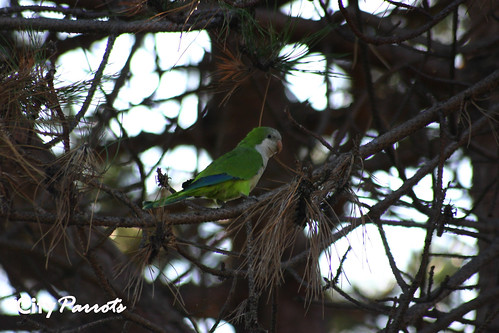Almost lost in the flurry of election coverage last month was a long-awaited ruling by the state Appellate Court, ending the five-year battle over the Connecticut coastline's monk parakeet population.
The Darien-based Friends of Animals, Inc. lost its attempt to prevent the United Illuminating Co. from capturing the squawky, tenacious, hilarious descendants of South American settlers that -- legend has it -- escaped across Long Island Sound 40 years ago from a broken cargo box at JFK Airport.
Back around this time of year in 2005, bird lovers from West Haven to Bridgeport were threatening to boycott the use of holiday light arrangements at their homes to hit UI in its balance sheet because utility work crews used a team from the U.S. Agriculture to kill about 180 parrots.
The parrot-eradication controversy lasted weeks.
One West Haven woman was arrested after confronting UI crews that were grabbing the birds from a large stick nest in front of her house and handing them over to the DOA guys for on-the-spot gassing. The charges against her were thrown out of court.
There was a public-relations backlash against the utility, which miscalculated the extent that the birds had endeared themselves as loud representatives of the tropical jungle for many suburban and urban dwellers with dim prospects of ever visiting South America.
The bright-green parrots, which often fly in loose, noisy formation in their foraging for food, are native to Paraguay, where they are found living in areas as high as 4,000 feet above sea level. They have survived severe Connecticut winters and prospered, with as many as seven pairs per nest.
For reasons that are still unclear, utility poles, with or without transformers up top, are desirable nesting locations for some of the gregarious colonies of monk parakeets, the only kind of parrots that makes nests of sticks.
They have made homes virtually up and down the coast, including major colonies at Stamford's Cove Island Park and all the way to Brooklyn and New Jersey.
Maybe it's the feel of the wooden poles, which reminds them of the fir trees they inhabit in places like Seaside Park in Bridgeport and the Shakespeare Theatre Park along the Housatonic River in Stratford.
United Illuminating made a major tactical mistake in neglecting routine maintenance of more than 100 of these poles, from West Haven to Bridgeport, that attracted bird nests, which grew larger and larger and larger still over the years.
The utility eventually claimed that the nests were causing safety problems and even fires and power outages, while bird lovers said squirrels were a bigger problem.
The Appellate Court, however, supported a Superior Court dismissal of the case against UI. Priscilla Feral, president of the Friends of Animals, told me last week that they will not appeal the issue to the Supreme Court.
"I think it's hopeless and we've had to pay for the lawsuit," Feral said.
"The silver lining here is, in five years UI hasn't captured them, which resulted in their deaths," Feral said. "The magic is the litigation at least put enough pressure on them that they didn't recklessly kill parrots anymore."
Al Carbone, spokesman for UI, said last week that there are no plans to capture the birds again.
"We remove the nests twice a year, in the spring and fall, or if they get in the way of doing work, or if customers call us," Carbone said.
Part of the birds' tenacity is their penchant for reconstructing.
When UI tore down nests, the birds immediately rebuilt, jamming fresh sticks into the utility poles's tiniest crevices and eventually creating more large avian condos.
Carbone indicated that the parrot's proliferation may have reached its limit. Where dozens of poles had been colonized, now only a few are being used.
"We have definitely seen a decrease in the number of nests," Carbone said, noting that the June tornado hit the parrot population hard, particularly in Bridgeport and Stratford's Lordship neighborhood.
"During our October inspections there were 31 nests removed, including nine in Stratford and five in Bridgeport."
Feral said she's encouraged by UI's more passive plans to continue the seasonal nest tear-downs and avoid bringing in the DOA for parrot slaughter.
She will campaign next year for the General Assembly to reinstate the parrots among the birds protected by Connecticut's Wild Bird Act. "We have to change this to make sure it's not up to UI to decide whether they will continue to kill and vivisect these birds," Feral said.
For the moment, the state's monk parakeets will be allowed to peacefully coexist.
